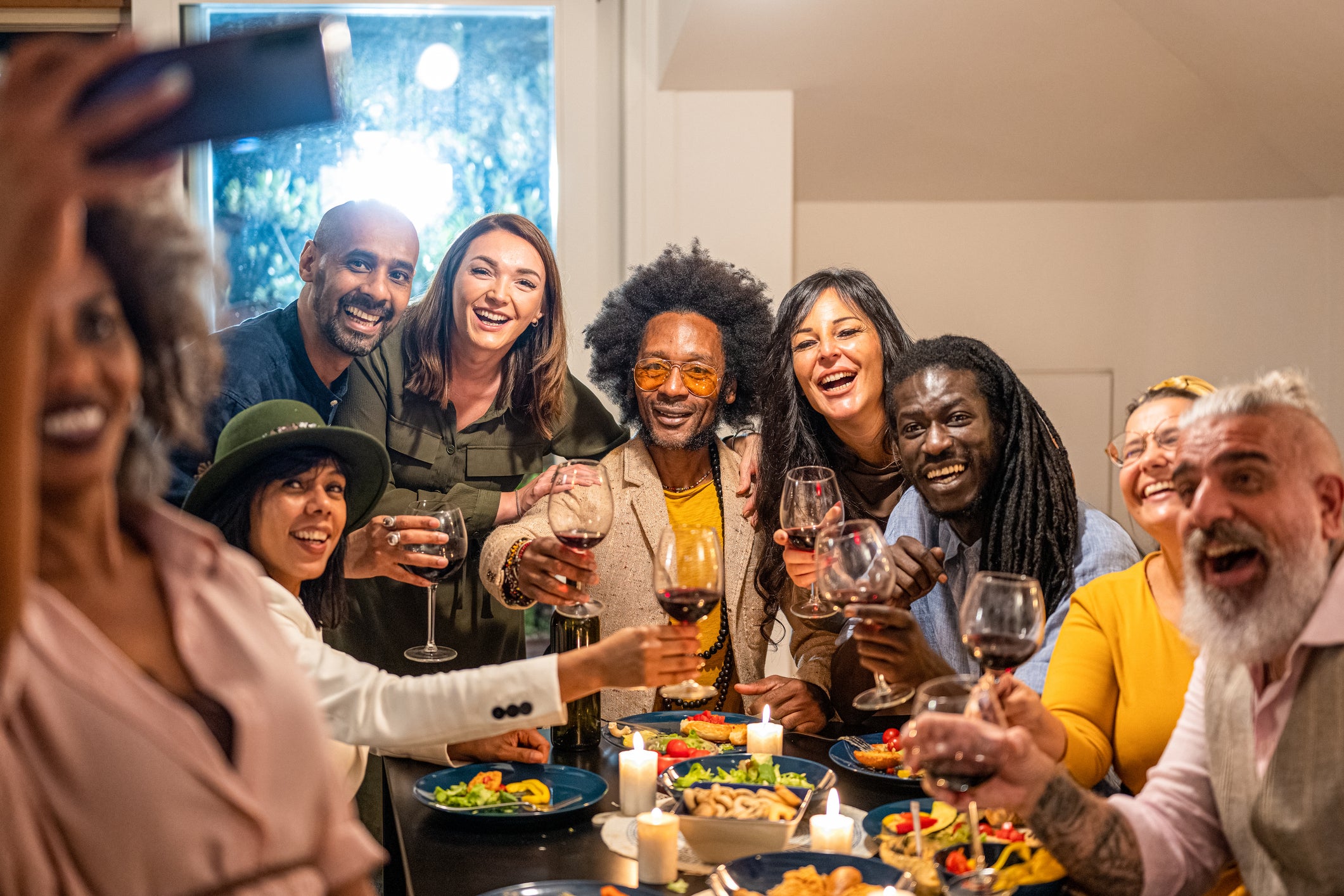I thought it would be easy. I thought I could do it with barely a thought. But when I sit down and try to list 150 friends – people with whom I have a reciprocal and ongoing relationship – I start struggling at around 134.
It’s a little embarrassing. I’m a normal(ish), outgoing woman in her thirties; if anything, I’m probably more sociable than your average bear, one of those desperately sad keenos that loves to join a committee or a club or even just a Whatsapp group. And yet here I am, scrolling through my phone in a desperate bid to mop up the people I’ve somehow missed.
I must stress that I didn’t pluck this number – 150 – out of thin air. It is known as “Dunbar’s Number”, named after the academic who first came up with it: Robin Dunbar. While his official title is Emeritus professor of evolutionary psychology at the University of Oxford, a better one might simply be “the friendship don”. He’s been studying the ins and outs of human relationships – or, as he calls it, “the behavioural, cognitive and neuroendocrinological mechanisms that underpin social bonding in primates (in general) and humans (in particular)” – for more than 50 years.
Dunbar first proposed that humans’ natural social circles were capped at around 150 after studying the brains of monkeys and apes. He was testing a general theory about brain size and group size. Chimps naturally congregate in troops of around 50, for example; “When I plugged human brain size into this equation, it predicted a group size of about 150,” he tells me.
Like any good researcher, Dunbar went off and looked for real-world evidence that backed up this curiously round number – and found a surprisingly large amount of it throughout human history. He found it in hunter gatherer societies, the kind we evolved in before settling in bigger communities. He found it in historical datasets, like the Doomsday Book. He found it in Italian Grazing Association documents, and in Amish and Hutterite church plants, and in fishing communities’ census data. In more recent history, he found it seemed to apply to friendships: it was in people’s Christmas card lists in the Nineties (back when everyone actually sent Christmas cards), and in their annual call logs (a large dataset of phone records counted the number of contacts with whom a person had exchanged at least one phone call each way over the course of a year).
The results have even replicated on social media. Looking at their biggest sample so far, a Facebook data set of 61 million users in the US, Dunbar and his team found that the average number of Facebook friends listed per person was, rather extraordinarily, 149. Even Dunbar was surprised. “You don’t often get predictions that close to reality,” he says wryly.
This latest finding somewhat debunks the idea that, because we have more access to – and means through which to communicate with – more people than ever before in human history, we have expanded our networks in any meaningful way. “You’d think that social media might cut through the key constraint, which is simply access,” says Dunbar. “You might wonder whether the digital world is able to expand our circle to unlimited numbers. But the answer is, it doesn’t.”

It’s gratifying to hear this. One of the main reasons I started looking into the number of friendships we’re capable of realistically having simultaneously is that I found myself feeling increasingly guilty about my inability to grow friendships with new people while also maintaining deep bonds with old friends. The internet and social media have exacerbated this perceived inadequacy. Because at any given moment I could message that university course mate on Facebook, DM my old colleague on Insta or WhatsApp that lovely woman I met on holiday, it feels like I’m failing every time I don’t. In the old days, I’d have inevitably lost the lovely woman’s address and moved on with my life. Now, it’s yet another stick to beat myself with.
Then there’s the fact that, ever since I moved from London to a much smaller town, I’ve felt the pressure to befriend everybody I meet. Within this much-reduced community, it’s bizarrely hard to accept that some people will remain mere acquaintances instead of BFFs. Maybe it’s because there are fewer potential pals – it gives the illusion that I could catch ’em all, Pokémon style, if I only tried hard enough.
But, of course, I can’t. Dunbar hypothesises that we initially evolved into certain group sizes for protection against predators – lions, and tigers, and bears, oh my! – and then protection against other humans. There were other benefits in terms of having a big enough community to help with harvesting crops and taking care of children. But there’s something else interesting, too, that he’s observed with other mammals: group sizes are often tied to optimal numbers for information sharing around networks. “It’s essentially about knowing who’s who, and what they’re doing, and who they’re friends with, and building up a picture.”
You might wonder whether the digital world is able to expand our circle to unlimited numbers. But the answer is, it doesn’t
Professor Robin Dunbar
The size of your personal network might vary depending on whether you’re an introvert or an extrovert – as one might imagine, the former tend to have fewer but closer friends, the latter to have more friendships that aren’t as deep – but try to go too far above 150 and “you weaken the quality of the friendships because you spread your capital too thinly,” warns Dunbar. “Our social capital is fixed because, ultimately, it’s about time investment, and time investment creates emotional capital.” Ie: we have a finite amount of physical time to spend communicating with others, whether IRL or online, and it is this time that builds a bond. “You can carve the cake in different ways; the thing you want to be careful about is not over-carving it,” he adds. “If you overdo it, and carve too thin, you will pay a penalty.”
Though a huge body of research has proven the massive health benefits of friendships (in longevity medicine it’s up there alongside diet, exercise and sleep), quality tends to beat quantity. There’s a Goldilocks-style “just right” sweet spot when it comes to our social networks; Dunbar cites a study that looked at the link between friendships and the risk of developing depression. The results suggested that having either too few or too many friends meant someone was “very likely to suffer depression in the future”. But if they had about five really close friends, the risk was vastly reduced.
This is the same conclusion that Dunbar came to: not all friends are created equal. To make it into the overall 150, a person has to be someone you try to contact, and vice versa, at least once a year. They’re someone you wouldn’t feel strange about having over to your home; they might make it into the invite list for a big, one-off event, like your wedding. But within that, there are various layers of closeness.
Picture concentric rings on a dartboard spreading out from you, the bull’s eye. Most of us will have around five ride-or-die, “shoulder to cry on” mates (which could include certain family members or a significant other). These are the people whose doorsteps you could show up at, weeping, at 3am. This group is instinctively easy to pinpoint on my own personal friendship “map” – and, sure enough, it numbers precisely five.

There is very little turnover in this core group, with someone only moving out of it around once a decade, according to the data. Communication is key – these are people you’d be in contact with once a week, minimum. Otherwise, “they will start to drift out of that circle,” says Dunbar.
Next up is a layer of 15, which includes the tight five plus an extra 10 who are, in Dunbar’s words, “your major social friends, the people you see regularly, including family members”. These are people you’d see at least once a month; about 60 per cent of your time and attention for socialising go to these 15 individuals. It takes a little bit more thought, but this group, too, is fairly straightforward to identify on my list.
Then there’s the “weekend backyard barbecue party group”, as Dunbar has previously described it, a cohort of 50 that includes the original 15. I actually get to about 57 here (finally, my overactive social life pays off), and then plough on with trying to list my overall 150. After some dedicated effort and WhatsApp hunting I tap out at 153. In practice, Dunbar’s number appears to be astonishingly accurate.
The idea of a magic number remains beguiling, and the evidence for it compelling
Not all academics agree, of course. One 2021 study by Stockholm University researchers posited that 150 was an underestimation, and that no cut off can be accurately calculated. Dunbar himself has identified a horseshoe shape in the data according to age – the younger and older we are on the graph, the fewer total friends we’re likely to have. But the idea of a magic number remains beguiling, and the evidence for it compelling.
While we’ll likely never be conscious of any kind of “one in, one out” policy going on when it comes to our circle, reflecting on the way that friendships evolve proves enlightening. There’s an almost symbiotic process going on in the carefully balanced ecosystem of our social lives; as some relationships wane, others naturally wax to take their place, and vice versa. It takes time for people to move outwards through the layers and the decay usually occurs directly in line with frequency of contact. According to Dunbar, the data suggests that it takes a full two to three years for someone to slip from your inner 15 to outside your 150.
But the main thing to remember is that some kind of ebb and flow throughout our lifetimes is completely natural. As much as modern technology might conspire to make us feel like we’re constantly failing, friendships have seasons and are often situational. The person you buddy up with on a night out because you’re the last two propping up the bar is unlikely to become a life-long chum; the school-gate parents you gravitate towards when your child is small might not stand the test of time once offspring fly the nest. We can’t be friends with everyone. A stranger might be a friend you just haven’t met yet – but it’s OK if they stay a stranger, too.



0 Comments